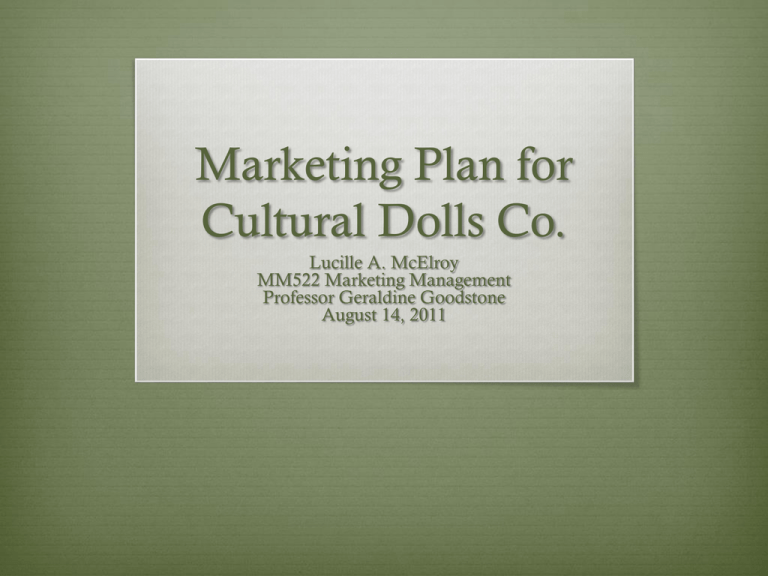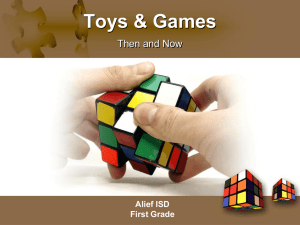
Marketing Plan for
Cultural Dolls Co.
Lucille A. McElroy
MM522 Marketing Management
Professor Geraldine Goodstone
August 14, 2011
Situational Analysis
Customers. Children, mostly girls ages 4 to 12, avid doll collectors
are the end users. Major retail stores to carry the dolls in their store
shelves.
Company. Sole proprietorship.
The doll market is a 2.77 B industry. Competitors are Mattel Inc.,
MGA (Bratz Dolls)
Market Summary
Demand for toys, dolls and games has been on the
rebound with the gradual economic recovery. In 2010,
consumer sentiment and household disposable income
rose for the first time in two years, encouraging consumers
to increase their spending that they delayed during tough
times. Revenue for the Hobby and Toy industry
(IBISWorld report 45112) increased by 2.0% in 2010 and
is estimated to increase by 3.1% in 2011. Such increases in
downstream demand are expected to lead to higher
demand at the manufacturing level; IBISWorld anticipates
that industry's sales will increase by 1.7% from 2010 to
2011.
Company Description
Cultural Doll Co. was created in February 2007 by a sole
proprietor.
Management is composed of a manager with an education
background in Commerce, including a Bachelor of Commerce
major in Accounting from University of San Carlos and
graduate work on MBA program from Keller Graduate School
of Management. Her work experience includes 10 years of
business operations and 10 years as Controller.
The executive talent, who conceptualized the dolls through her
creative sketches, has expertise in Art Design and drawings
including clothing and fashion design. She is an avid doll
collector herself
External
Internal
SWOT Analysis
Positive
Negative
Strengths
Weaknesses
Internal positive aspects
under our control on
which we may wish to
capitalize
Internal negative aspects
under our control which
we plan to improve
Years of positive
experience in training
Experience in
collaborating with other
organizations
Designer’s health
challenges,
communication
challenges with China.
Opportunities
Threats
Business for Doll
Industry increased by
6% in 2010. Disposable
income rose in 2010 by
2.0%
A not so strong funding
base to successfully
market the product, kids
are influenced by
advertisements.
Environmental Scan
Economic. Consumer Spending Index grew by 1.4% in
June 2009 from May 2009, a sign that shoppers may be
feeling optimistic about their spending habits and economic
growth.
Environmental. Steady supply of raw materials needed to
produce the cultural dolls
Technological. Trend on Video Games has the biggest
share of total traditional to industry. 85% of toy industry.
Growing demand for fun voice dolls.
Political. Consumer Product Safety Improvement Act.
Competition
Mattel, Inc., a publicly held company who takes .20%
of the total Doll Industry (MAT) www .mattel.com
MGA Entertainment, a privately held company,
makers of Bratz Dolls. Private Company Ticker
Symbol (MGAEP) www.mgae.com. 08% market
share. Being a private company, only 2006 and 2007
figures were available at www.privco.com
We are unique and different because the face is
unique. Upcoming line is a voice doll with a capacity
of an iPod shuffle. There’s nothing like it out there.
Product Offering
The Cultural Dolls send a healing
message towards differences in one’s
culture. An interesting, creative and
educational doll that reflects the diversity
of the world in which we live today is
offered by Cultural Dolls Co. Our dolls
are different from the others in such a
way that the look is unique.
Market Strategy
The target market are kids, usually girls at ages 4-12,
avid doll collectors as end users. Retail stores are
targeted to carry these products at their shelves to give
consumers varied choices.
They would be interested in our product due to the
diversity and the need for parents to get the younger
generation to have ties with their roots since this
nation is a melting pot of races.
Price point is dependent on volume ordered and
would like to come in low for consumers to try the
product out.
Mission Statement
Cultural Dolls is a developer of
collectible quality, educational,
Cultural dolls and accessories, based
in Los Angeles. The company's
mission is to create unique dolls and
related accessories that help children
and adults embrace international
heritage, culture and tradition.
Marketing Plan Objectives
Non-Financial Objectives
Serving customers
Periodic surveys will be sent in order to understand the
needs and wants of customers. Online surveys such as
PollDaddy.com linked with an Application c]Programming
Interface (API) of e-Newsletters.
Financial Objectives
Increase profits, as a percentage of revenue, by 1% every
two quarters.
Hold marketing expenses, as a percentage of sales at 5%
with a 2% increase after year two.
Consumer Segment Analysis
The target market segment is identified as major retail
stores such as Toys R Us, Wal-Mart, Target and KMart. Mass merchants and general toys stores capture
the largest share of toy purchases. Forty-two percent
of consumers made their most recent toy purchase
purchase at a mass merchant store such as Kmart or
Wal-Mart, and 33% made their purchase at a general
toy store such as Toys ‘R’ Us. A likely reason is the
large variety of children’s products from which to
choose.
Actual Target Market
End users are kids, usually girls ages 4-12. The
parents purchase the doll for them. Income would be
low to moderate income families. Education level
would be at least some education in grade school. My
son when he was in kindergarten had already topics
about diversity.
Marital status. Single, who purchase for their nieces,
or for a wish-list for indigent children. Married who
love and care for their children.
Psychographic. Loyal to one’s heritage and culture.
Marketing Mix
The marketer's task is to device marketing activities and assembles
fully integrated marketing programs to create, communicate, and
deliver value for consumers. Marketing activities come in all forms.
The marketing mix is comprised of the first P, product. The product
is cultural dolls and accessories.
The second P is price. The doll is intended to sell at $18. An
American Girl doll at an average really costs $24.
The third P is place. Retail store display is the place one can buy the
ethnic dolls. There will be an upsell of doll clothing and accessories
available as an order form enclosed in each doll packaging.
The fourth P is promotion. Promotional efforts is geared to reach the
target audience, to be well exposed to its products through Point of
Purchase (POP) displays.
Promotion Strategies
The management of Cultural Doll Co. believes very
strongly in press releases to significantly get the word
out of the value of what it does. This will always be a
focus of its promotion efforts. However, though this is
a crucial part, this is only one part of its promotion
strategy. On a consistent basis the company will be
promoting what it does through online Internet
exposure through search engine optimization, eBay,
retail stores, and by word of mouth. This along with
all the individual selling efforts of its staff
demonstrates a dynamic way for it to build the
penetration of what it does in the marketplace.
Promotion Budget
Budget for web design
$5,000.00
Representation at Retail Stores
740.00
Search Engine Optimization
4,540.00
TV Advertisement
10,000.00
Characterization of cultural doll in
103,220.00
Point of Purchase (POP) displays
5,000.00
Promotion, sweeps, viral marketing
10,000.00
Total Promotion Budget
$138,500.00
Total Budget
$2,770,000.00
Total Promotional Budget
$138,500.00
Percentage of Promotion Budget to Total Budget
5%
Contingency Planning
Once a corporation is located as a potential target of cultural
dolls, Davison Group will gather production and marketing
information concerning the company. Davison Group will do
this representation so they can work harder to better design the
project to fit with the company’s abilities. As a disclaimer. A
typical project does not get licensed, sell in stores or generate a
profit. Plan B is to attract equity investors, participate in
Mixers of Angel Investors and Entrepreneurs to present the
business proposition to do marketing and production on our
own. Plan C, business investment at risk is a tax deduction. As
a qualified investor, you can put your experience and
contribution to the investor’s repertoire for future endeavors.
Executive Summary
The company will penetrate the market in the design
and distribution of a female multicultural doll that
will be welcomed by children and people of all
cultural backgrounds and nationalities. There is an
opportunity for offering superior quality dolls
featuring different hair color, eye color, skin tone, hair
texture and clothing according to the country she is
visiting or representing. Cultural Doll Co. will serve
its area of business working to make its lines more
productive while at the same time controlling
expenses.
Keys to Success & Critical Issues
Utilize the management team’s networking abilities to stay on the
forefront of marketplace innovation
Deliver a line of products are high of quality and fun to play with
Control all areas of the product – from conception, marketing to
distribution
Perform operations at a low cost at all times
Introduce cutting edge materials in dolls that are made safe for
children
Communication skills are widely regarded as among the most
critical success factors in interpersonal, professional and business
relationships.
References
112th Congress. (2011, July 30). House Rule 2715. Retrieved August 14, 2011, from Congress website:
http://rules.house.gov/Media/file/PDF_112_1/Floor_Text/CPSC_Disc1.pdf
Barros, I. D. R. (1998, February). The Business of Barbie. Retrieved August 8, 2011, from ITT.edu
website: http://trex.id.iit.edu/~ibarros/cases/Barbie99.pdf
Employment Projections Program, U.S. Department of Labor, U.S. Bureau of Labor Statistics. (n.d.).
Industries with the fastest growing and most rapidly declining wage and salary employment. Retrieved
August 16, 2011, from Employment Projections Program, U.S. Department of Labor, U.S. Bureau of Labor
Statistics website: http://www.bls.gov/emp/ep_table_203.htm
Fierro, C. (2010, October 9). How much does an American Girl doll really cost? See full article from
DailyFinance: http://srph.it/nGIyoB [Daily Finance]. Retrieved August 8, 2011, from Daily Finance website:
http://www.dailyfinance.com/2010/10/09/how-much-does-an-american-girl-doll-really-cost/
First Research. (n.d.). First Research Industry Profiles.
Grizzly Bear Financial Managers. (2011). Investment Manager Marketing Plan [Marketing Strategy].
Retrieved August 1, 2011, from Palo Alto Software website:
http://www.mplans.com/_manager_marketing_plan/_strategy_fc.php
IBISWorld Company Report Mattel, Inc. [Data file]. (2011). Retrieved from
http://clients.ibisworld.com.proxy.devry.edu/enterprise/financialsannual.aspx?entid=1177
IBISWorld. (n.d.). Industry Performance of Toy, Doll and Game Manufacturing in US [Data file].
Retrieved from http://clients.ibisworld.com.proxy.devry.edu//.aspx?indid=894
Kahrs, K. (2005). Toy Company: Toys for a New Generation, Inc. (Vol. No. 1). Retrieved from
http://go.galegroup.com.proxy.devry.edu/ps/i.do?&id=GALE%7CCX3439700040&v=2.1&u=devry_down
ergrov&it=r&p=GVRL&sw=w
Kokemuller, N. (2011, March 12). Marketing Plan Strategy and Objectives [Fact sheet]. Retrieved
August 1, 2011, from eHow Money website: http://www.ehow.com/_8052726_marketing-plan-strategyobjectives.html
Kotler, P., & Keller, K. L. (n.d.). Marketing Management (13th edition ed.). Upper Saddle River, New
Jersey : Pearson Prentice Hall.
Nemec, J. (2002, September 1). Getting a clearer vision of the refractive marketplace. Opthalmology
Times, 27(17), 10. Retrieved from Ebscohost database. (7276908)
Non-financial objectives of a business . (n.d.). Retrieved August/1, 2011, from tutor2u website:
http://www.tutor2u.net///_nonfinancial_objectives.htm
The NPD Group / Consumer Panel Tracking, The NPD Group / Retail Tracking, & Toy Association.
(2010). State of the Industry [2009 to 2010 Comparison in Total U.S. Dollars]. Retrieved August 14,
2011, from Toy Association website:
http://www.toyassociation.org/AM/Template.cfm?Section=12_Rolling_Months
Toy Industry Association, & Consumer Electronics Association. (2007). Consumer Perceptions of
Electronic Toys. Retrieved August 14, 2011, from IBISWorld US Toy, Doll & Game Manufacturing
website: http://www.toyassociation.org/AM/PDFs/Research/TIAElectronicToysResearch.pdf










